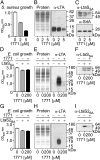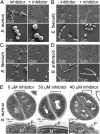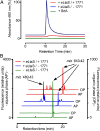Small molecule inhibitor of lipoteichoic acid synthesis is an antibiotic for Gram-positive bacteria
- PMID: 23401520
- PMCID: PMC3587227
- DOI: 10.1073/pnas.1217337110
Small molecule inhibitor of lipoteichoic acid synthesis is an antibiotic for Gram-positive bacteria
Abstract
The current epidemic of infections caused by antibiotic-resistant gram-positive bacteria requires the discovery of new drug targets and the development of new therapeutics. Lipoteichoic acid (LTA), a cell wall polymer of gram-positive bacteria, consists of 1,3-polyglycerol-phosphate linked to glycolipid. LTA synthase (LtaS) polymerizes polyglycerol-phosphate from phosphatidylglycerol, a reaction that is essential for the growth of gram-positive bacteria. We screened small molecule libraries for compounds inhibiting growth of Staphylococcus aureus but not of gram-negative bacteria. Compound 1771 [2-oxo-2-(5-phenyl-1,3,4-oxadiazol-2-ylamino)ethyl 2-naphtho[2,1-b]furan-1-ylacetate] blocked phosphatidylglycerol binding to LtaS and inhibited LTA synthesis in S. aureus and in Escherichia coli expressing ltaS. Compound 1771 inhibited the growth of antibiotic-resistant gram-positive bacteria and prolonged the survival of mice with lethal S. aureus challenge, validating LtaS as a target for the development of antibiotics.
Conflict of interest statement
The authors declare no conflict of interest.
Figures





Similar articles
-
Lipoteichoic acid synthesis inhibition in combination with antibiotics abrogates growth of multidrug-resistant Enterococcus faecium.Int J Antimicrob Agents. 2017 Mar;49(3):355-363. doi: 10.1016/j.ijantimicag.2016.12.002. Epub 2017 Feb 7. Int J Antimicrob Agents. 2017. PMID: 28188831
-
Antibacterial Small Molecules That Potently Inhibit Staphylococcus aureus Lipoteichoic Acid Biosynthesis.ChemMedChem. 2019 May 17;14(10):1000-1004. doi: 10.1002/cmdc.201900053. Epub 2019 Apr 30. ChemMedChem. 2019. PMID: 30939229
-
Synthesis of glycerol phosphate lipoteichoic acid in Staphylococcus aureus.Proc Natl Acad Sci U S A. 2007 May 15;104(20):8478-83. doi: 10.1073/pnas.0701821104. Epub 2007 May 3. Proc Natl Acad Sci U S A. 2007. PMID: 17483484 Free PMC article.
-
Teichoic acid biosynthesis as an antibiotic target.Curr Opin Microbiol. 2013 Oct;16(5):531-7. doi: 10.1016/j.mib.2013.06.014. Epub 2013 Jul 31. Curr Opin Microbiol. 2013. PMID: 23916223 Free PMC article. Review.
-
Lipoteichoic acid synthesis and function in gram-positive bacteria.Annu Rev Microbiol. 2014;68:81-100. doi: 10.1146/annurev-micro-091213-112949. Epub 2014 May 5. Annu Rev Microbiol. 2014. PMID: 24819367 Review.
Cited by
-
TerC Proteins Function During Protein Secretion to Metalate Exoenzymes.Res Sq [Preprint]. 2023 May 17:rs.3.rs-2860473. doi: 10.21203/rs.3.rs-2860473/v1. Res Sq. 2023. Update in: Nat Commun. 2023 Oct 4;14(1):6186. doi: 10.1038/s41467-023-41896-1. PMID: 37292672 Free PMC article. Updated. Preprint.
-
Lipoteichoic acid of Streptococcus gordonii as a negative regulator of human dendritic cell activation.Front Immunol. 2023 Mar 28;14:1056949. doi: 10.3389/fimmu.2023.1056949. eCollection 2023. Front Immunol. 2023. PMID: 37056772 Free PMC article.
-
Lipoteichoic acid biosynthesis by Staphylococcus aureus is controlled by the MspA protein.mBio. 2024 Aug 14;15(8):e0151224. doi: 10.1128/mbio.01512-24. Epub 2024 Jul 22. mBio. 2024. PMID: 39037275 Free PMC article.
-
Modulation of Lipoteichoic Acids and Exopolysaccharides Prevents Streptococcus mutans Biofilm Accumulation.Molecules. 2020 May 9;25(9):2232. doi: 10.3390/molecules25092232. Molecules. 2020. PMID: 32397430 Free PMC article.
-
Mirubactin C rescues the lethal effect of cell wall biosynthesis mutations in Bacillus subtilis.Front Microbiol. 2022 Oct 13;13:1004737. doi: 10.3389/fmicb.2022.1004737. eCollection 2022. Front Microbiol. 2022. PMID: 36312962 Free PMC article.
References
-
- Magiorakos AP, et al. Multidrug-resistant, extensively drug-resistant and pandrug-resistant bacteria: An international expert proposal for interim standard definitions for acquired resistance. Clin Microbiol Infect. 2012;18(3):268–281. - PubMed
-
- Neu HC. The crisis in antibiotic resistance. Science. 1992;257(5073):1064–1073. - PubMed
-
- Payne DJ, Holmes DJ, Rosenberg M. Delivering novel targets and antibiotics from genomics. Curr Opin Investig Drugs. 2001;2(8):1028–1034. - PubMed
-
- Projan SJ. Why is big Pharma getting out of antibacterial drug discovery? Curr Opin Microbiol. 2003;6(5):427–430. - PubMed
-
- Walsh CT. Molecular mechanisms that confer antibacterial drug resistance. Nature. 2000;406(6797):775–781. - PubMed
Publication types
MeSH terms
Substances
Grants and funding
LinkOut - more resources
Full Text Sources
Other Literature Sources
Medical

